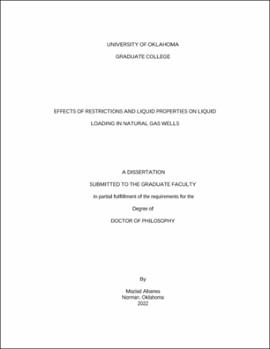| dc.contributor.advisor | Karami, Hamidreza | |
| dc.contributor.author | Alsanea, Maziad | |
| dc.date.accessioned | 2022-12-08T22:21:23Z | |
| dc.date.available | 2022-12-08T22:21:23Z | |
| dc.date.issued | 2022-12-08 | |
| dc.identifier.uri | https://hdl.handle.net/11244/336894 | |
| dc.description.abstract | Liquid loading is one of the main challenges in the later life of a natural gas well. Several methods have been used to unload the gas wells and remedy liquid loading, with various efficiencies. The literature revealed a lack of two-phase flow experimental data under low liquid loading conditions. Furthermore, studies on the effect of restrictions used a limited number of water-air experimental data in the churn flow region. Intensive experimental tests were carried out in this study to address this gap in the literature and to better understand the effects of restrictions and liquid properties on two-phase flow and liquid loading in vertical pipes. Common available models, namely OLGA and Tulsa University Fluid Flow Project (TUFFP) unified models, provided inadequate predictions for pressure drop and liquid holdup in the churn region. Therefore, a mechanistic model was developed to better predict the pressure drop and liquid holdup in the churn region.
A total of 376 data points was collected in a state-of-the-art 0.0508-m ID vertical flow loop. Two liquids, namely, water and mineral oil were used with air as the gas phase. Tests were conducted without and with ring-shaped partial restrictions, with two IDs of 1.5 and 1.75 in. The superficial liquid and gas velocities were varied from 0.0033 to 0.02 m/s and from 1 to 27.5 m/s, respectively, to cover annular and churn flow patterns. Flow pattern, pressure drop, and liquid holdup were measured and analyzed.
The investigation revealed that for low liquid rates in vertical flow, a positive friction gradient can exist. Compared to the minimum-pressure drop technique, the positive frictional pressure technique offers considerably more reliable predictions for the onset liquid loading. The experimental results showed the differences in flow behavior of water-air and oil-air flows become more pronounced in the churn flow region, with lower holdup and pressure drop for oil-air flow, possibly due to the higher entrainment.
The tests with insert in the churn region showed a thin layer of liquid film reversing with entrained droplets travelling upward before the insert. After the insert mixing and agitation occurred generating high-amplitude liquid waves and preventing liquid fallback. The insert has a positive impact at lowering the liquid holdup and pressure drop within the churn flow region, particularly at lower liquid rates.
A 1-D mechanistic model was developed for vertical flow based on momentum and mass balances to predict the pressure drop and liquid holdup of two-phase flow by considering the effect of liquid entrainment in the gas core. In addition, a model was developed to predict the interfacial friction factor f_i, based on the calculated f_i from the experimental data. The proposed mechanistic model with the developed model for f_i showed better performance than existing models especially for low liquid rates and oil-air flow. | en_US |
| dc.language | en | en_US |
| dc.rights | Attribution-NonCommercial-NoDerivatives 4.0 International | * |
| dc.rights.uri | https://creativecommons.org/licenses/by-nc-nd/4.0/ | * |
| dc.subject | Natural gas well | en_US |
| dc.subject | Liquid loading | en_US |
| dc.subject | two-phase flow | en_US |
| dc.subject | effect of liquid properties | en_US |
| dc.subject | effect of restriction | en_US |
| dc.subject | effect of inserts | en_US |
| dc.subject | churn flow model | en_US |
| dc.subject | interfacial shear stress model | en_US |
| dc.subject | Gas well deliquification | en_US |
| dc.title | Effects of restrictions and liquid properties on liquid loading in natural gas wells | en_US |
| dc.contributor.committeeMember | Kazempoor, Pejman | |
| dc.contributor.committeeMember | Teodoriu, Catalin | |
| dc.contributor.committeeMember | Wu, Xingru | |
| dc.contributor.committeeMember | Putra, Satya | |
| dc.date.manuscript | 2022-12-08 | |
| dc.thesis.degree | Ph.D. | en_US |
| ou.group | Mewbourne College of Earth and Energy::Mewbourne School of Petroleum and Geological Engineering | en_US |
| shareok.orcid | 0000-0002-5836-1242 | en_US |
| shareok.nativefileaccess | restricted | en_US |

